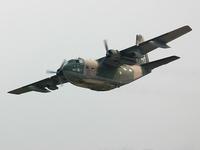-
Exposure to IED blasts increases risk of long-term health consequences
Blasts are the leading cause of death and injury on the battlefield, accounting for about 75 percent of all combat-related injuries in U.S. military personnel. U.S. soldiers exposed to blasts while deployed in Iraq and Afghanistan have an increased risk of developing adverse health outcomes over the long term, such as post-traumatic stress disorder (PTSD) and, in certain cases of traumatic brain injury (TBI), growth hormone deficiency, and persistent post-concussive symptoms including headaches, says a new report.
-
-
Israeli jets attack Syrian weapons convoys in Hezbollah-held area in Lebanon

For the second time this year. Israeli jets attacked targets on the border between Lebanon and Syria on Monday night as part of an ongoing campaign to prevent the transfer of advanced weapon systems from the Syrian military to Hezbollah. In 2013, the Israel Air Force (IAF) attacked military bases and arms depots inside Syria on six occasions — 30 January, 3 May, 5 May, 5 July, 18 October, and 30 October. The first attack in 2014 took place on 26 January. The previous seven air strikes were on targets inside Syria, but last Sunday attack was on Syrian military convoys just inside Lebanon, in Hezbollah-controlled areas near the Lebanon-Syria border.
-
-
After failing 5 February deadline, Syria wants 100-day extension to remove chemicals
After missing the 5 February deadline to have all its chemical weapons removed from its territory, Syria has submitted a new 100-day plan for their removal. The international group monitoring the operation says the completion of the removal can be accomplished in less time than that. The Organization for the Prohibition of Chemical Weapons (OPCW) executive committee met on Friday in The Hague to discuss the joint OPCW and UN mission at a time when there is a growing international frustration with Syria over its failure to live up to its commitments.
-
-
Aircraft used in Vietnam source of postwar Agent Orange contamination in U.S.

During the Vietnam War, in an operation called Operation Ranch Hand, approximately twenty million gallons of herbicides, including around 10.5 million gallons of dioxin-contaminated Agent Orange, were sprayed by about thirty-four C-123 aircraft. These aircraft were subsequently returned to the United States and were used by Air Force reserve units between 1971 and 1982 for transport operations. Air Force reservists who flew these planes were exposed greater levels of dioxin than previously acknowledged.
-
-
Sandia Lab leading multidisciplinary effort to counter WMD
Threats of terrorism and weapons of mass destruction do not seem as imminent today as they did after the 9/11 attacks, but Jill Hruby, vice president of International, Homeland, and Nuclear Security at Sandia Labs, says that scientists, industry, and universities working on technological solutions to national security challenges must anticipate what could come next. Speaking at AAAS annual meeting, Hruby said that in an environment of lower public interest — due, in part, to the success of early efforts to combat terrorism that resulted in fewer major incidents in recent years — continued collaboration between national security laboratories, academia, and industry is needed.
-
-
Israeli defense company launches cybersecurity solutions section
In recent months the Israel Aerospace Industries (IAI) has increased its cyberdefense-related activities. Esti Peshin, director of the company’s cyber section and a veteran of the IDF’s hush-hush sigint Unit 8200, says IAI is now developing solutions for clients in Israel and abroad. “We’re a start-up, but with the backing of a company that earns $3.5 billion a year,” she said. Ultimately, she implied, these defensive measures can be turned into offensive capabilities. “Intelligence is a subset of attack,” Peshin said. “This is, first of all, a national mission.”
-
-
New cyber-attack model helps hackers time the next Stuxnet
Taking the enemy by surprise is usually a good idea. Surprise can only be achieved if you get the timing right — timing which, researchers argue, can be calculated using a mathematical model, at least in the case of cyber-wars. The researchers say that based on the stakes of the outcome, a cyberweapon must be used soon (if stakes are constant) or later (if the stakes are uneven). In other words, when the gain from a cyberattack is fixed and ramifications are low, it is best to attack as quickly as possible. When the gain is high or low and ramifications are high, it is best to be patient before attacking.
-
-
Unmanned aerial logistics system to bypass ground-based threats, challenges
Rugged terrain and threats such as ambushes and Improvised Explosive Devices (IEDs) can make ground-based transportation to and from the front lines a dangerous challenge. Combat outposts require on average 100,000 pounds of material a week, and high elevation and impassable mountain roads often restrict access. Unmanned aerial logistics system would bypass ground-based threats and enable faster, more effective delivery of cargo and other essential services in hard-to-reach areas.
-
-
Israeli legal expert urges development of ethics code for cyberwarfare
Col. Sharon Afek, former deputy military advocate general, says that countries would benefit from developing an ethics code to govern cyber warfare operations. He notes that existing law already prohibits cyber operations which would directly lead to loss of life, injury, or property damage, such as causing a train to derail or undermining a dam. “Israel faces a complex and challenging period in which we can expect both a cyber arms race with the participation of state and non-state entities, and a massive battle between East and West over the character of the future legal regime,” he writes. He acknowledges, though, that only a catastrophic event like “Pearl Harbor or Twin Towers attack in cyberspace” would accelerate developments in this area.
-
-
Most of Libya’s chemical weapons destroyed
When Libya joined the Chemical Weapons Convention in December 2003, it reported to the Organization for the Prohibition of Chemical Weapons (OPCW) that it was operating three chemical-weapons production facilities, and that it had produced a total of twenty-five tons of sulfur mustard gas, 3,563 bombs with warfare agents, and 1,390 tons of precursor materials. Over the next eight years, these chemical weapons stock were systematically destroyed under international supervision. The work was halted between February and November 2011 – the beginning of the rebellion against Qaddafi and his departure from power – and resumed in early 2012. OPCW announced than on 26 January 2014, work on destroying Libya’s mustard gas has been completed. The question is whether the Qaddafi regime was truthful in its 2003 declaration – or whether there are still stocks of chemical agents stashed somewhere in desert caches.
-
-
First full-system mechanical environment test of B61-12 nuke completed successfully
The U.S. National Nuclear Security Administration (NNSA) announced the successful completion of the first full-system mechanical environment test of the B61‑12 as part of the NNSA’s effort to refurbish the B61 nuclear bomb. This first full-system mechanical environment test is one of several critical milestones for the B61-12 Life Extension Program (LEP). The B61-12 will replace the existing B61-3, -4, -7, and -10 bombs. Fielding the B61-12 will also enable the retirement of the B83, the last U.S. megaton class weapon, in the mid-to-late 2020s.
-
-
U.S. Navy probes exam cheating at school for nuclear power reactor operator
Yet another military service is facing allegations of exam-cheating. Earlier this year, the U.S. Air Force launched a probe into a cheating scandal involving about 100 officersat Malmstrom Air Force Base, Montana, who are responsible for maintaining and operating land-based nuclear missiles. Now the U.S. Navy is investigating about one-fifth of its trainers at the school for naval nuclear power reactor operators in Charleston, South Carolina. The sailors are accused of cheating on written tests required to obtain certification as instructors at the nuclear propulsion school.
-
-
New research on ocean conditions to aid Navy planners

The Office of Naval Research Global (ONR Global) announced last week a grant to the University of Melbourne which will provide new insights into ocean conditions — crucial information for Navy planners involved in tactical and strategic decision-making. The goal of the effort is to provide the best information possible on the environmental, or battlefield, conditions, so that tactical and strategic decisions can be properly made.
-
-
Chemical, defense companies subject to Chinese Nitro attacks
More and more chemical and defense companies around the world are victims of Nitro attacks. These attacks, launched by government-backed Chinese hackers, install PoisonIvy, a Remote Access Tool (RAT) stealthily placed on computer systems to steal information. The majority of the computers infected belong to firms in the United States, Bangladesh, and the United Kingdom.
-
-
National Guard units help states ward off cyberattacks
Governors across the United States are mobilizing their states’ National Guard units to combat threats from cyberattacks. The state of Washington was the first state to assign the state’s National Guard cybersecurity responsibilities. The state recognized the potential of its National Guard as a cyberforce when it realized that many of its soldiers, who are full-time employees and part-time soldiers, worked for tech employers such as Google, Boeing, Cisco, Verizon, and Microsoft.
-
More headlines
The long view
Tantalizing Method to Study Cyberdeterrence
Tantalus is unlike most war games because it is experimental instead of experiential — the immersive game differs by overlapping scientific rigor and quantitative assessment methods with the experimental sciences, and experimental war gaming provides insightful data for real-world cyberattacks.
Testing Cutting-Edge Counter-Drone Technology
Drones have many positive applications, bad actors can use them for nefarious purposes. Two recent field demonstrations brought government, academia, and industry together to evaluate innovative counter-unmanned aircraft systems.
European Arms Imports Nearly Double, U.S. and French Exports Rise, and Russian Exports Fall Sharply
States in Europe almost doubled their imports of major arms (+94 per cent) between 2014–18 and 2019–23. The United States increased its arms exports by 17 per cent between 2014–18 and 2019–23, while Russia’s arms exports halved. Russia was for the first time the third largest arms exporter, falling just behind France.
How Climate Change Will Affect Conflict and U.S. Military Operations
“People talk about climate change as a threat multiplier,” said Karen Sudkamp, an associate director of the Infrastructure, Immigration, and Security Operations Program within the RAND Homeland Security Research Division. “But at what point do we need to start talking about the threat multiplier actually becoming a significant threat all its own?”
The Tech Apocalypse Panic is Driven by AI Boosters, Military Tacticians, and Movies
From popular films like a War Games or The Terminator to a U.S. State Department-commissioned report on the security risk of weaponized AI, there has been a tremendous amount of hand wringing and nervousness about how so-called artificial intelligence might end up destroying the world. There is one easy way to avoid a lot of this and prevent a self-inflicted doomsday: don’t give computers the capability to launch devastating weapons.
